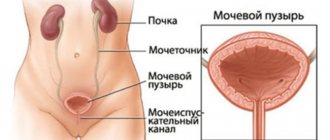The essence of the disease and the bacterium Gardnerella vaginalis
In a woman’s vagina there is a certain microflora, including a lot of microorganisms, both beneficial (lactobacillus) and opportunistic. Their ratio in a healthy woman is optimal for the health of the reproductive system and the whole body.
In certain situations, opportunistic flora begins to actively multiply, displacing beneficial flora.
The microorganism Gardnerella vaginalis belongs to the category of opportunistic pathogens. Normally, its amount in the genital tract is negligible or completely absent.
When the biocenosis is disrupted due to the use of antibiotics, promiscuous sexual intercourse, or the use of contraceptive suppositories, Gardnerella vaginalis actively multiplies , displacing beneficial microorganisms.
Gardnerellosis is called bacterial vaginosis, which develops due to dysbiosis of the genital tract. With this disease, pathogenic microbes have a negative effect on the vagina, causing an inflammatory process.
What is gardnerellosis?
The term gardnerellosis defines a change in the normal microflora of the vaginal mucosa in women, represented by lactobacilli. Their number decreases, microorganisms of the bacteria Gardnerella (Gardnerella vaginalis) and other representatives of opportunistic (opportunistic microflora) appear. In this case, inflammatory changes on the mucous membrane have not yet developed. Lactobacilli are representatives of normal microflora; when present in sufficient quantities on the mucous membrane, they prevent the activation of representatives of opportunistic microflora, and also prevent pathogenic microorganisms from multiplying. With a decrease in the number of lactobacilli, nonspecific protection of the mucous membrane of the vagina and vulva decreases, which contributes to the activation of opportunistic microorganisms, primarily Gardnerella. The process is not accompanied by the development of an inflammatory reaction, but without restoration of normal microflora, the risk of developing other infectious diseases increases.
In men, gardnerella can develop on the mucous membrane of the urethra (urethra), where normally there should be no microorganisms at all. Infection occurs when having unprotected sex with a woman suffering from gardnerellosis.
An infectious process accompanied by an increase in the number of gardnerella is more often recorded in women.
Where does the pathology come from: causes and routes of transmission
Where does Gardnerella come from in women, what are the reasons for its appearance? Gardnerellosis develops for a number of reasons , which gynecologists consider classic:
- the use of potent antibiotics that kill microflora in the intestines and vagina, undermining the optimal ratio of microorganisms;
- douching that women do on their own, as a result, the beneficial flora is simply washed away;
- use of antiseptics with a powerful antibacterial effect for douching;
- the use of contraceptives containing the substance 9-nonoxynol, which can have a detrimental effect on lactobacilli;
- promiscuity, frequent change of sexual partners;
- sexual intercourse without contraception.
For gardnerella to begin to actively multiply, causing bacterial vaginosis, several reasons are needed.
Although in women with a weakened immune system, the disease can start in the presence of one factor.
Infection occurs through sexual contact without barrier contraception.
Is gardnerella transmitted from woman to man and vice versa, can a man infect a woman? The source of infection is a sick woman. The main routes of infection are from women to men and vice versa.
Although doctors say that gardnerella cannot take root in the male body, men act as a carrier of the microorganism.
Some argue that there is an oral method of infection. But it has been proven that gardnerella cannot exist and develop on the mucous membrane in the oral cavity. Therefore, this route of transmission is questioned.
For men:
Gardnerellosis, by definition, is vaginal dysbiosis. Therefore, it is wrong to make such a diagnosis for men. Sometimes pathogens of gardnerellosis cause urethritis in men, which is manifested by burning and pain when urinating. In this case, treatment is necessary. In other cases (detection of Gardnerella vaginalis by precise methods; gardnerellosis in a sexual partner), there is no need to treat men.
With normal immune status, about 25% of men are carriers of gardnerella, that is, they do not have any manifestations of infection.
Carriage develops when Gardnerella vaginalis enters the male genital tract. Only under conditions of sufficiently strong immunosuppression are the development of balanoposthitis, urethritis, and prostatitis possible (approximately 15% of all cases).
Gardnerellosis is not a sexually transmitted disease. Sexual transmission has not been proven. However, it is closely associated with risk factors for sexually transmitted diseases (multiple sexual partners, recent change of sexual partner). Therefore, it is advisable for women with gardnerellosis to be examined for major sexually transmitted diseases.
Classification
Like most diseases affecting the female genitourinary system, gardnerellosis has a certain classification. Gynecologists often classify the disease according to its severity:
- bacterial vaginosis of the compensated type - with this course, analyzes indicate a slight presence of opportunistic flora in patients;
- bacterial vaginosis of the subcompensated type - the number of beneficial lactobacilli is significantly reduced with an increase in opportunistic flora, including gardnerella;
- vaginosis of the decompensated type - beneficial flora is almost completely replaced by pathogenic flora, the inflammatory process is strong, pronounced, changes in the epithelial layer are characteristic.
Prevention measures
It will not be possible to cure Gardnerella forever - it is an integral component of the vaginal microflora. But it is quite possible not to allow it to become active. Promiscuous sexual relations should be excluded. It is necessary to strengthen the immune system, treat all diseases in a timely manner, and use hygiene products without fragrances. You also need to undergo medical examinations with a gynecologist at least 2 times a year.
A woman is considered recovered if a repeated laboratory examination does not reveal an increased number of gardnerella in the smear. If you follow medical recommendations, the prognosis is favorable. The vaginal microflora is restored, and all symptoms of pathology disappear.
Clinical picture
The disease can affect women at any age, including very young girls and older women.
How does gardnerella manifest itself in women?
Pathology can develop:
- asymptomatic - the disease is diagnosed by tests, the woman does not make any complaints, there is no pain or discharge;
- with a pronounced clinical picture - pain and cramping, discharge, poor health.
The incubation period of gardnerella in women - from the moment gardnerella enters the genital tract until the moment of manifestation - ranges from a week to 20 days.
During this period, pathogenic flora begins to gradually spread, displacing beneficial flora.
The onset of the disease is characterized by mild symptoms - slight discomfort, weak discharge .
A clear clinical picture appears on days 14-20 - symptoms are pronounced, discharge is abundant, pain and discomfort are maximum.
The main signs indicating the development of gardnerellosis:
- A bad odor from the genital tract is the first symptom of the development of vaginosis; the smell is fetid, pungent, similar to the aroma of decaying fish, which is caused by the decomposition of amines due to the rapid proliferation of gardnerella.
- Vaginal discharge - their character changes depending on the severity. At the initial stage, the discharge looks like a mucous translucent and turbid liquid; as the pathology worsens, the discharge becomes gray, opaque, viscous, and acquires a green or yellow tint.
At an advanced stage, the discharge forms layers on the walls of the vagina, causing swelling and redness. A characteristic feature of discharge from gardnerellosis is a foul odor.
- Sudden disruptions in the menstrual cycle may indicate the development of bacterial vaginosis.
- Discomfort in the area of the genitourinary organs - as the pathogenic flora multiplies, itching and burning appear in the urethra, labia, vagina, the mucous membranes may look swollen and inflamed.
- The development of diseases affecting the organs of the urinary system - urethritis, cystitis indicate gardnerellosis. This is due to the close proximity of the genital and urinary organs.
- Pain during sexual intercourse - pain can occur immediately during intimacy and persist after it.
- Pain during urination - occurs when infection spreads to the urethra.
- General malaise - pathology can lead to a general disturbance of health, a feeling of weakness, possibly an increase in temperature, as a result of the active proliferation of negative microbes.
Causes and symptoms
The causes of gardnerellosis in women are classic:
- long-term use of antibacterial drugs, against the background of which the immune system weakens, the microflora in the intestinal tract and vaginal cavity is disrupted, and the normal balance of microorganisms is disrupted;
- uncontrolled, excessively frequent douching with antiseptic agents, as a result of such procedures, beneficial microflora is washed out of the vaginal cavity;
- frequent douching with products that have an antibacterial effect;
- the use of contraceptives that contain a substance called 9-nonoxyl, this component has the ability to negatively affect the number of lactobacilli;
- Promiscuous sexual activity, frequent intimate contacts with changing sexual partners, especially if you do not use barrier contraceptives.
To provoke the active development of the causative agent of the disease in women, different provoking factors are needed. But if a woman suffers from a weakened immune system, only one predisposing condition is usually sufficient for the development of the disease. Where does the pathogen come from and how is it transmitted? The source of the infectious process is an infected person. Transmission occurs during unprotected sexual contact. In a man’s body, such a bacterium most often does not take root, since this is due to the anatomical structure of his genital organs (when urinating, most pathogenic microorganisms are washed out of the urethra).
Causes and symptoms
How is the disease transmitted? Infection occurs through intimate contact with an infected person, and women have a much greater chance of becoming infected than men. Infection occurs through sexual contact without the use of barrier-type contraceptive methods. Is the pathogen transmitted from a representative of the weaker sex to a representative of the stronger sex and, on the contrary, is a man capable of infecting a woman? The source of infection is an unhealthy girl. The key lines of infection are from the weaker sex to the stronger sex, and vice versa.
Symptoms of gardnerellosis in women are determined by the severity of its course and form. In some cases, the disease may be completely asymptomatic. The disease can be recognized by test results, and the woman simply does not have any complaints; there may be no pain or discharge with gardnerellosis. Otherwise, the situation is dramatically different; symptoms such as pain, pain, weakness, and copious discharge from the genitourinary tract appear. The duration of the incubation period varies from seven days to three weeks. During this period, active replacement of lactobacilli with pathogenic agents occurs.
In the initial period, mildly expressed signs appear, such as a slight feeling of discomfort and mild vaginal discharge. But after two weeks, pronounced symptoms appear:
- presence of a strong unpleasant odor;
- pain, discomfort in the genital area and lower abdomen;
- copious discharge of various types (depending on the degree of development of the pathological process: at the initial stages of development, such signs in women are translucent, but when the development of the pathology worsens, such signs appear more intensely, they are gray, greenish or yellow;
- redness, swelling, hyperemia of the vaginal walls;
- disruptions in the menstrual cycle;
- painful sensations during and after intimacy;
- pain when emptying the bladder, often accompanied by cystitis in women;
- general weakness, hyperthermia (usually subfebrile, which indicates the active development and reproduction of pathogenic microorganisms.
Without eliminating the cause, the pathological process will worsen again over time if conditions are favorable for it.
Diagnostic measures
The danger of the disease lies in its possible hidden course, without complaints or signs. At the same time, a woman, unaware of the presence of vaginosis, can infect her sexual partners.
With the bright onset of the disease, timely seeking medical help is important. The doctor who treats gardnerellosis is a gynecologist.
Diagnosis of the disease should be comprehensive; it is important to differentiate gardnerellosis from other diseases of the genitourinary system - vulvitis, colpitis, chlamydia.
Basic methods of diagnosis:
- Gynecological examination. At the initial appointment, the doctor collects information about sexual life, contraceptive methods, and cycle regularity. An examination on a chair using gynecological speculum to examine the vagina is mandatory.
- Taking a smear for laboratory and microscopic studies, during which the presence of pathogenic microorganisms will be determined.
- Taking a smear for markers of vaginosis.
- Determining the acidity level in the vagina using special test strips.
- PCR diagnostics is a polymer chain reaction method.
- A reaction to isonitrile is a substance that appears in the vagina during gardnerellosis and gives the discharge the smell of rotten fish.
A woman with gardnerellosis has a low number of lactobacilli in the smear - 20-30% instead of the required 90%, an increased number of leukocytes, an alkaline environment instead of an acidic one. When examining the smear, it is clear that the native cells are completely covered with gardnerella.
A general clinical analysis of blood and urine allows us to determine the severity of the pathology and its spread to the urinary organs. After confirming the diagnosis, the doctor may additionally perform a colposcopy to determine the presence of inflammatory processes in the cervix.
Diagnostics
Diagnostic measures must be carried out in a complex manner; it is important to distinguish this disease from colpitis, vulvitis, and chlamydia. Most often, in order to detect the disease, the following research methods are used:
- Gynecological examination. The patient must be examined on a chair; mirrors are used to examine the vaginal cavity and uterus.
- Collection of anamnestic data, the doctor needs information about what kind of sex life the patient has, what methods of contraception are used, whether the menstrual cycle is regular.
- Gardnerella is usually detected in a smear. To do this, a smear is taken for examinations that allow you to determine the amount of the microorganism.
- The acidity concentration is determined using special test devices.
- PCR method to determine the number of bacteria in the vagina.
If gardnerella is detected in the smear, usually the number of lactobacilli is negligible, less than the norm, and a positive test for alkaline acid is also present. When examining the smear, the doctor discovers that the entire surface of the epithelial cells is covered by the gardnerella bacterium. A general analysis of blood fluid is also additionally prescribed. When a diagnosis is made, a colposcopy is performed to determine whether there are inflammatory reactions in the cervical area.
Why is infection dangerous?
This disease is not purely sexually transmitted , but concomitant treatment is necessary. With a long course of gardnerellosis without classic signs - discharge, pain, discomfort in the genital tract - serious complications can develop.
In women, untimely and incorrect treatment can provoke the development of inflammatory diseases of the pelvic organs, including adhesive disease, metroendometritis - inflammation of the muscular layer of the uterus.
Other consequences:
- endometritis;
- damage to the fallopian tubes up to complete obstruction;
- chronic diseases of the urinary system - pyelonephritis;
- infertility.
With timely access to a gynecologist and adequately prescribed therapy, gardnerellosis can be successfully treated.
Even an advanced disease can be cured by completely restoring women’s health.
Diagnosis of gardnerellosis
To identify pathology, it is important to consult a doctor and conduct appropriate research.
Which doctor diagnoses and treats gardnerellosis?
Women need to visit a gynecologist, men – a venereologist.
The diagnostic principles are the same for both sexes:
- initial examination and medical history;
- microflora smear from the vagina/urethra.
In the smear, attention is paid not so much to the presence of Gardnerella, but to its quantitative ratio, because the bacterium is opportunistic.
How and what to treat: drug regimens
Treatment is carried out in several stages:
- destruction of the pathogen itself;
- restoration of microflora in the vagina;
- general strengthening therapy - to improve immunity.
Antibiotics
The first stage, aimed at suppressing pathogenic flora and further preventing its growth. It is important to determine the sensitivity of Gardnerella to antibiotics so that treatment is successful.
The main groups of antibiotics used in the treatment of gardnerellosis:
- broad-spectrum antibiotics - Clindamycin, Metronidazole - kill the culprit of the disease and other microorganisms - staphylococcus, E. coli;
- derivatives of imidazoles - Trichopolum, Tinidazole - these drugs are destructive against gardnerella, trichomonas, which often join the course of the disease;
- antiseptic drugs - Macmiror - act more mildly than antibiotics, but additionally prevent the growth of fungi in the vagina, preventing thrush.
Antibiotic therapy lasts an average of 7-10 days in dosages calculated depending on the age, weight of the patients, and the severity of inflammation.
The generally accepted dosage is at least 500 mg per day for drugs containing metronidazole, trichopolum; 300 mg - for Clindamycin.
For mild to moderate disease, a single dose of Metronidazole in a volume of 2 g is possible.
Candles
The use of suppositories is important when the disease is not advanced. Basically, suppositories are actively prescribed to pregnant women , because their advantage is not a systemic effect on the entire body, but an effect on the problem area - the genital tract, the vagina.
Drug therapy with suppositories is carried out for 7-8 days; in severe cases, the period is increased to 10 days. The dosage is selected individually by the gynecologist, usually the maximum is prescribed in the first 2-3 days, then the dose is slightly adjusted.
Popular suppositories in the treatment of gardnerellosis:
- Terzhinan is a complex drug in the form of vaginal tablets that contains antimicrobial and antifungal components;
- Metrovagin - contains metronidazole, which is harmful to anaerobic infections;
- Hexicon - suppositories containing chlorhexidine, which destroys harmful microbes without affecting lactobacilli;
- Macmiror in the form of suppositories has a detrimental effect on opportunistic and pathogenic microorganisms, and additionally contains nystatin.
Other medicines
After destroying the pathogen, it is important to continue treatment with medications that will relieve unpleasant symptoms in the vagina and restore the balance of microflora.
Lactobacilli in the form of suppositories or tablets for oral use will help establish the “correct” biocenosis: itching, burning, and discomfort in the stomach will go away.
For such purposes the following are prescribed:
- Bifidumbacterin in the form of lyophilisate;
- Acylact in the form of suppositories;
- Lactobacterin - suppositories and powder.
The course of treatment should be at least 14 days, more often it will take a month for the beneficial microflora to take root and local immunity to rise - in the intestines and vagina.
To generally strengthen the immune system, immunomodulators are prescribed to help resist the proliferation of pathogenic flora.
The following remedies are most effective:
- Wobenzym;
- Genferon in candles;
- Immunal;
- Interferon.
The course is from 10 to 14 days, after a break it can be repeated for better effect.
Folk remedies
Traditional medicine is safe; their action is based on herbs and plant materials with an antimicrobial and astringent effect - oak bark, chamomile, sage, string.
Oils that can heal damaged mucous membranes are used - olive, sea buckthorn.
But despite the safety, it is better not to carry out treatment without a doctor’s permission . Traditional methods can be used in combination along with drug therapy to relieve symptoms.
Herbs and other remedies made from oils and honey are not able to destroy the pathogen and prevent the development of the disease.
Popular traditional medicine recipes for the treatment of gardnerellosis:
- douching with oak bark infusion (200 ml of boiling water per 10 g of raw material) before bedtime for a week;
- douching with an infusion of chamomile and plantain (a glass of boiling water for 20 g of a mixture of herbs) at night, course - 10 days;
- tampons with sea buckthorn oil - soak sterile gauze with heated oil, roll it up and insert it into the vagina overnight, course - 7-10 days.
Optimal duration of therapy, partner treatment
The average duration of treatment for bacterial vaginosis is almost 2 months , of which antibiotic therapy lasts 7-10 days, about 14-30 days the microflora is restored by taking biological products, about 2 weeks are needed to increase the body's defenses.
Difficult to treat - the disease may return. At the slightest provoking factors - hypothermia, stress - gardnerella begins to become active again. Therefore, it is important to repeat courses of drug therapy periodically.
Treatment of the partner is a prerequisite. Although gardnerellosis does not cause severe disease in men, inflammation of the urethra can occur. And a woman who has recovered from the disease can re-pick up the infection from an untreated partner.
Men are more often prescribed antimicrobial agents in the form of ointments and creams (Metronidazole gel) - they act on the source of inflammation, destroying the pathogen.
It is important for both the woman and the partner to carry out a control examination; if there is no infection or clinical manifestations in the smear, the disease is considered defeated.
The doctor will tell you in detail about the treatment of this disease:
Treatment of gardnerellosis
Treatment of gardnerellosis in men and women is complex. It is carried out in 2 stages and involves the destruction of the causative agent of the infectious process, followed by normalization of the microflora of the mucous membranes, as well as the functional state of the immune system. The first stage of treatment includes the use of antibacterial agents that are active against gardnerella. Antibacterial agents of the semisynthetic penicillin group (Amoxicillin) or cephalosporins (Ceftriaxone) are usually prescribed. The duration of antibiotic therapy is determined by the severity of the infectious process; it should not be less than 5 days. Together with antibiotics, antiseptics are prescribed for local use in the form of rinsing or douching in women (chlorhexidine solution).
At the second stage of therapeutic measures in women, preparations for local use based on lactic acid (probiotics) are used, which makes it possible to increase the activity of lactobacilli. If necessary, plant-based immunomodulators are prescribed (ginseng, eleutherococcus, lemongrass). The duration of the second stage of treatment for gardnerellosis is at least 2 weeks (in women, it may take several months to restore normal vaginal microflora).
The prognosis for gardnerellosis in men and women is generally favorable. Lack of treatment leads to the development of complications, which include various inflammatory processes in the internal organs of the reproductive system, which is the result of a decrease in the protective properties of the mucous membranes.
Gardnerellosis in pregnant women
This scourge is also diagnosed in pregnant women at different stages. The disease does not pose a danger to the fetus - bacteria cannot reach the child through the blood and placenta.
But untreated pathology can complicate the course of pregnancy and the birth process, as well as the condition of the woman herself.
List of possible complications:
- premature birth;
- early rupture of the amniotic sac;
- postpartum endometritis - inflammation in the uterus.
It is possible and necessary to treat gardnerella in women during pregnancy. Gynecologists prescribe softer, gentle drugs with local action.
Antibiotics are contraindicated , especially in the early stages. Suppositories with clindamycin or Terzhinan vaginal tablets destroy pathogenic flora in the vagina without being absorbed into the general bloodstream, and penetration through the placenta is excluded.
Equally important for pregnant women being treated for vaginosis is the consumption of fermented milk products in the form of bio-yogurt and kefir. This helps create the right balance of beneficial bacteria.
It is important for pregnant women to periodically undergo smears to determine “harmful” microflora in order to promptly diagnose and treat infectious diseases of the genital tract.
Pathways of pathogen transmission
In most cases, gardnerella vaginalis is transmitted during sexual contact, regardless of the type of penetration of the partner (orally, anally or vaginally).
In rare cases, contact-household transmission of the pathogen is possible, for example, when using bedding, towels or underwear from a sick person.
It is also possible to transmit Gardnerella from mother to fetus during childbirth, however, the pathogen cannot multiply in the child’s body, since the activation and vital activity of Gardnerella requires glycogen, which is very little in the body of a newborn.
Potentially dangerous for people is the carrier of the pathogen - a person who is infected but does not have pronounced clinical symptoms of gardnerellosis. In addition, carriage of the pathogen significantly increases the risk that in the future, under the influence of the predisposing factors mentioned above, a person may develop the disease.
Consequences, prognosis: can it be cured completely and forever?
If treatment is carried out competently, using antimicrobial drugs, restoratives and medications that help restore the “correct” microflora, the risk of negative consequences for the body is minimized.
A common complication is a weakening of the body's defenses . He needs time to get back to normal.
If the disease has been advanced, problems with the urinary tract (cystitis) and reproductive health (failure of the menstrual cycle, inflammation of the ovaries and appendages) may occur.
In general, the prognosis is favorable, and serious complications are rare. The main thing is to recognize the disease at the very beginning.
Symptoms of gardnerellosis
The disease can occur in acute and chronic form . In acute form in women it is characterized by:
- itching and discomfort in the vagina;
- copious discharge;
- the smell of rotten fish in the discharge, which does not disappear even after hygiene procedures.
The discharge can be of different colors - yellow, green, white, transparent and white-gray, as well as of different consistency - mostly homogeneous creamy or watery, and may foam. All this speaks of an inflammatory process that occurs in the pelvic organs.
In the chronic stage, there are practically no symptoms. If the chronic stage turns into a period of exacerbation , then the woman may experience itching and burning of the vaginal mucosa, pain during and outside of sexual intercourse, her labia may swell and turn red. However, it cannot be said with one hundred percent certainty that a woman suffering from such symptoms is faced with gardnerellosis, because a large number of diseases have the same symptoms, including candidiasis, chlamydia, and gonorrhea. Therefore, the appearance of any of them is a reason to immediately consult a doctor.
In men, the bacterium gardnerella vaginalis cannot exist in the body for a long time. In 90 percent of cases, the man does not experience discomfort and does not even notice the infection. However, in extremely rare cases, it can manifest itself in the form of balanoposthitis or urethritis. In this case, the diagnosis of gardnerella is not made; in men, this disease is diagnosed as nonspecific gardnerella - an associated, that is, mixed, infection, the signs of which are:
- itching and hyperemia of the glans penis;
- increased urination and discomfort.
In even rarer cases, discharge from the penis, itching, burning and an unpleasant odor may occur. If your urine smells like missing fish, urgent consultation with a specialist is required, as in this case the problem may have gone very far.
Treatment of Gardnerella vaginalis during pregnancy
In general, the treatment of vaginosis during pregnancy has its own characteristics associated with restrictions on antimicrobial therapy. During this period, the woman’s body undergoes hormonal changes. They activate many hidden pathologies, against the background of which the growth of Gardnerella is revealed. Gardnerella poses no direct danger to the fetus - the fetus is reliably protected from its influence by the placenta. And even if the bacteria gets on the baby’s skin during birth, no inflammatory reaction will occur. This does not mean at all that the disease can be started during pregnancy. If gardnerella is relatively safe for the embryo, then the vaginal walls may become inflamed, and in particularly advanced cases, complications such as uterine bleeding, postpartum endometritis, other diseases of the genitourinary system, etc. may occur. If gardnerella is not detected and treated in time, during pregnancy, there is a risk of miscarriage.
Basically, treatment during pregnancy is similar: a course of antimicrobial drugs, a restorative course using lactobacilli, taking drugs that inhibit the growth of Gardnerella. From about the 20th week until the end of the first trimester of pregnancy, only vaginal suppositories are prescribed - they will not have a significant effect on the embryo. In the following months, internal medications may be prescribed. First of all, it is important to reduce the number of bacteria and eliminate the resulting inflammation. If the inflammatory processes cannot be eliminated, childbirth may require special preparation.
https://youtu.be/akCmw7ET76Q











